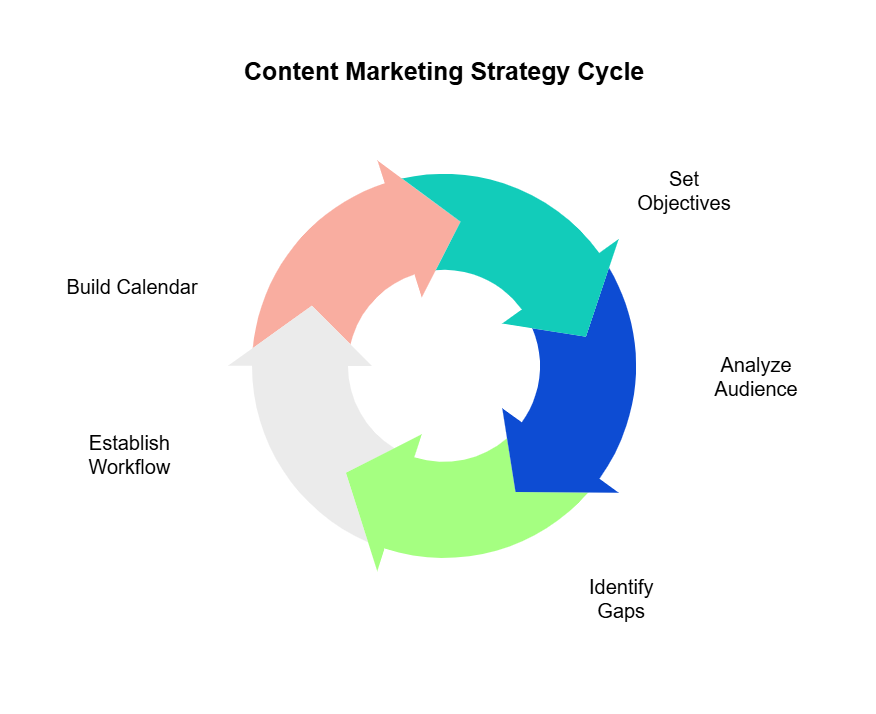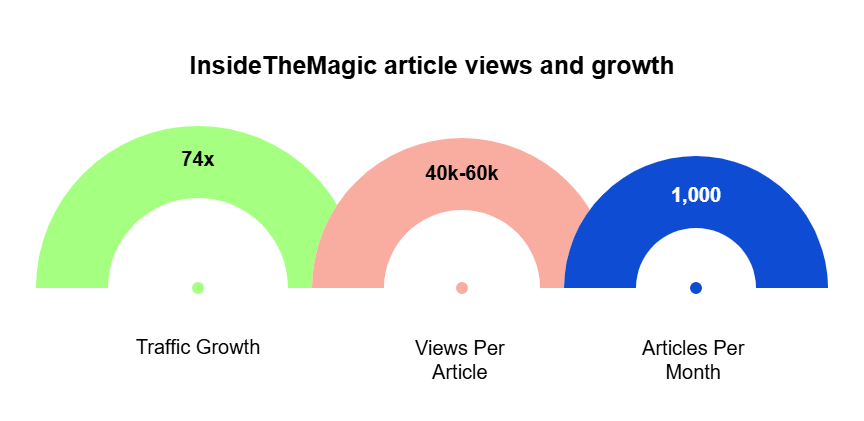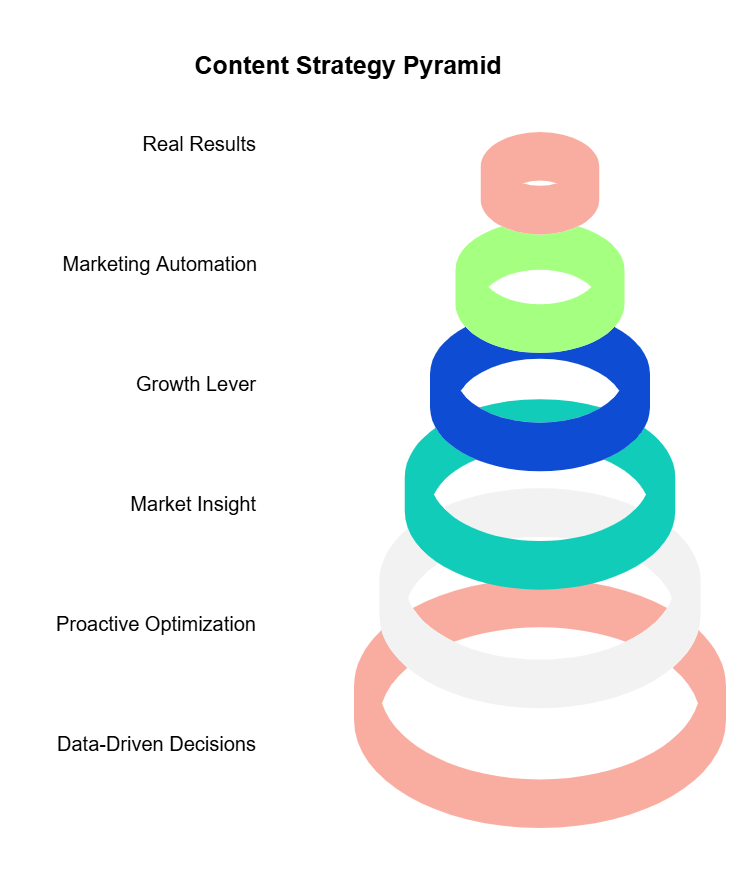Content marketing analysis turns content from a shot in the dark into a business advantage. The question isn’t “Did people see it?” but “Did it matter?” Real analysis shows what your audience cares about, where they come from, and which pieces change their behavior and convert.
You can spot what works and what quietly drags you down by focusing on the right numbers: traffic sources, engagement, conversions, and leads. When all this data lands in one place, patterns emerge you’d miss otherwise.
This isn’t a final box to tick. Analysis shapes every step: what you create, where you share it, and how you measure progress. Done well, it connects your creative work to results you can see and decisions you can defend. That’s how content becomes a true asset, not just another piece in the pile.
Build a content marketing strategy
A content marketing strategy based on analysis is concrete and specific, not a collection of vague promises. Use data at every step, from goal setting to content distribution, to guide your decisions.

Set objectives and define KPIs
Start with the outcomes you really want. New demo requests? A pipeline of qualified leads? Better newsletter signups? Spell out each target.
For example: “Source 100 sales-qualified leads per quarter from guides” or “Boost inbound enterprise win rate by 10 percent.”
Your KPIs must track these outcomes. Don’t bother with session counts if your real need is demo completions. If visitors land on your blog but few ask for demos, your KPI is “sessions ending on demo request,” not just raw traffic. That’s your signal to dig into CTAs, page flow, or on-page messaging.
No filler metrics. Stay laser-focused on what moves your business forward.
Analyze and segment your audience
Look at the real signals. Search patterns, repeat visits, and on-site actions tell you what your market cares about.
If repeat visitors spend hours on comparison pages, build more resources for decision-stage buyers. If LinkedIn brings in tech leaders but your product pages get small business owners, split the messaging and assets to speak to each group clearly.
Don’t treat your list like one big bucket. Break out your email content by persona: Send deep dives to IT managers, business outcomes to marketing directors. You’ll see stronger engagement and spot content gaps faster.
Identify content gaps and opportunities
Even the best strategy will stall if there are hidden blind spots. Once you’ve mapped goals and audience, take a hard look at what you already have. Use a content inventory or simple spreadsheet to list every asset, then score each one against its performance (traffic, conversion, engagement) and its role in the buyer journey.
Stack yours against the competition: Where do they answer questions you ignore, what do they rank for that you don’t, which formats or topics are they winning on? This step reveals areas to update, expand, or create from scratch. When you spot weak coverage or missing high-intent content, those become your next strategic plays.
Why does this matter? Because gaps leave you wide open to competitors aiming to steal your share. By making competitive analysis a routine, you’re always hunting for the next win, never just keeping up.
Use tools for content audits, competitor gap analysis, or even a manual search fact-finding spree. Create a prioritized list of topics, formats, or questions. Tie each one directly to a goal or persona segment.
Establish workflow and accountability
Plans collapse when nobody owns the outcome. You need a workflow that matches your ambition: who researches, who writes, who edits, who publishes, and who presses for iteration? It doesn’t have to be a sprawling Gantt chart. Just an unambiguous handoff from step to step will work fine.
Bottlenecks and missed deadlines usually aren’t a content quality problem but rather a process problem. When each part of the workflow has a clear owner and a clear timeline, execution turns into consistent, repeatable delivery.
How do you make it actionable? Map each stage of content creation to a person or team, then document your process (even as a simple checklist or playbook). Schedule regular check-ins or sprints. Make sure feedback loops are quick, and results get shared so everyone learns what’s working and what’s not.
Build your calendar and distribution plan
Don’t make the mistake of thinking that a calendar is merely a publishing checklist. You should really think of it as a tool for putting the right topics in front of the right people, at the right time. Check which formats and topics pull traffic that converts. Maybe your walkthroughs win organic, while webinars flop with no-shows. Respond in kind and plan more of what works.
Notice if finance readers grab whitepapers but ignore your blog? Create content bundles or targeted landing pages to test what gets them to subscribe or interact further.
Always put your strongest content on the platforms where your audience acts, not where everyone else is posting. Use every insight to tighten your content marketing plan. Shift resources, try new formats, and put your effort where it matters.
When you track and act on specifics, like “ten inbound leads from one search-optimized guide” or “webinar topics that drive CMO replies,” your strategy stays sharp and focused. Drop what stalls, double down on what proves out, and keep your plan clear-eyed and high impact.
Measure content marketing success
Proving success in content marketing means drilling into the numbers that signal progress against your unique business outcomes. The right approach moves beyond generic reporting, revealing the patterns, momentum shifts, and gaps that shape what your content team does next. Success is about showing how content influences real decisions, revenue, or retention, instead of just reporting activity.
Zero in on metrics that spotlight impact
High-value content marketing metrics connect each asset to a business result. Think qualified pipeline, deal velocity, or new customer activation. Refine your dashboards to show which content pieces influenced specific actions and users. Don’t just measure what’s most visible; measure what’s hardest to fake.
Turn analytics into strategy
Build analytics flows that mirror your buyers’ real journeys. Map content to every step, from first touch to hand-raise to renewal. Track sequence, along with single clicks to identify where content tilts a decision or supports a breakthrough conversation. The goal is drawing a direct path from idea to outcome.
Dig into context, not just numbers
To get true value from reporting, pair numbers with context. Ask: What did users expect when they landed on this page? Did a specific article get shared in closed industry circles or spark replies from target accounts? Match your quantitative data with audience intent and qualitative feedback, then use that intelligence to refine your choices. Improvement comes when you act on nuance vs. trendlines.
When you build this discipline into your workflow, content marketing becomes a real lever, driving outcomes that sales, strategy, and leadership notice. The real win: You stop guessing and start steering.
Improve content performance
Analytics show you what’s lagging. Now, it’s time to act. Successful teams treat performance data like a sprint map: spot the slowdowns, run tests, and make targeted changes. Here’s how to get more from every asset you publish.
Find and fix what’s dragging you down
Start with a content audit. Don’t just look for broken links or old facts. Check for pages with low engagement, high exit rates, or drop-offs before key conversion points. If a how-to guide consistently lags on time-on-page, dig into why: Is it too dense, buried in jargon, or missing visuals? Diagnose the friction and address it directly.
Upgrade for real results (not just rankings)
Tweak your content based on what the numbers say (beyond what Google trends report). If search engine queries bring unqualified visitors, adjust your headlines and introductions so they fit your real customers’ priorities.
When engagement lags, break up blocks of copy, add strong visuals, or clarify your call-to-action. Technical SEO helps, but audience experience wins. So, check for slow load times and poor mobile layouts, not just meta tags.
Test smarter, not just more
Don’t guess. Run focused tests with a purpose. Change one variable at a time, like a headline, CTA placement, or intro paragraph. Tie each test to a real goal, such as “increase newsletter signups by 15 percent” or “cut bounce rate on demo pages in half.” End each cycle by folding learnings into your content playbook so your next draft isn’t starting from scratch.
Continuous improvement turns feedback into action. The marketers that win are the ones that get sharper and more relevant with every revision.
Use social media to boost your content’s reach
Most brands treat social like a megaphone. The smart ones treat it like a laser. Your engaging content deserves more than a quick share and a hope for likes. Distribution should drive business results.
Find your audience where they are (not where you wish they were)
Skip the spray-and-pray approach. Check which platforms deliver engaged prospects. If your LinkedIn posts draw in decision-makers but X (Twitter) drives only surface clicks, adjust your investment accordingly. Use tools to track which social referrers send traffic that becomes leads or customers, not just visitors who bounce.
Adapt and repurpose, don’t just repost
Your audience’s behavior changes from platform to platform. Turn a dense whitepaper into a punchy infographic for LinkedIn, or a short video content for Instagram. Pull out quotable stats for X. Where possible, use analytics to see what gets saved, shared, or commented on, not just what’s seen.
Monitor impact and act fast
Don’t get distracted by vanity numbers. Measure how many visitors from each channel engage, subscribe, fill out forms, or reach out. If Facebook traffic lingers but never takes action, shift your focus. When a niche platform starts sending high-value leads, ramp up. Social media marketing is a live experiment. Refine as you go and double down where you see real movement.
Treat every social channel like an extension of your content strategy, not as a dumping ground. The brands that win are the ones that respond to what the numbers really say, and pivot quickly when the next big opportunity opens up.
Content marketing case studies: Data-driven wins in the real world
Curious what data-driven content marketing analytics looks like in practice? Here’s where strategy meets the real world.
Turning pageviews into profit — InsideTheMagic scales content (74x growth)
InsideTheMagic, a site for Disney fans, had a suite of common problems: heavy reliance on Facebook for traffic, low organic search visibility, and lots of writers but no unified process for quality. Owner Kurt Schmidt needed results that would stick, not just spikes.
He made using MarketMuse, our AI-powered content strategy platform, mandatory for every article. Writers used MarketMuse to build high quality content that answered fan questions and covered hidden topics, not fluff. Result:
- 74x traffic growth
- 40k–60k views per article
- A jump from 300 to 1,000 articles a month

Search and Discover now bring in the majority of its audience. (If you want details on how they pulled that off, read how InsideTheMagic built a traffic machine.)
Pro Tip: Create strict standards for content quality and train your team on one process. Use topic models to find hidden questions your audience cares about. If you want results like these, make the process non-negotiable.
Doubling qualified leads — Kasasa builds authority with data
Kasasa is a financial technology and marketing services company that partners with community banks and credit unions across the United States. Its goal: arm local institutions with the tools and products to compete with national banks — think innovative checking accounts, lending solutions, and targeted marketing.
Kasasa needed a bigger pipeline fast. It wanted authority in a trust-driven industry (financial services) and kept hitting bottlenecks with manual workflows and content guesswork.
The solution: MarketMuse’s research and content briefs. Kasasa cut planning time, put more high-quality content in the pipeline, and quickly identified which topics would drive real progress for conversions. The outcome:
- 92 percent YoY growth in organic entrances
- 83 percent more first-page keyword positions
- 28 percent more time on page
What this means for you: Use AI to target topics that build trust and attract high-value leads. Don’t create more content; create relevant content that answers your audience’s toughest questions.
From local player to national leader — Stick Shift Driving Academy’s 120 percent lead surge
Stick Shift Driving Academy is a national school specializing in teaching people to drive manual transmission vehicles (also known as “stick shifts”), serving students in dozens of markets. Its focus: help learners master a skill fewer automatics need but many car lovers (and employers) still want, from everyday drivers to automotive enthusiasts and commercial fleets.
Stick Shift Driving Academy had one shot: reach potential customers with urgent needs (learn stick shift, now) in dozens of markets. It struggled to publish fast enough or know what topics would drive bookings.
With MarketMuse, it built great content around searcher intent, not opinions. In months:
- 72 percent more traffic
- 120 percent more inbound calls
- 110 percent more form completions
It developed a simple, brief process so even interns could produce content that ranked.
Whiteboard it: Map your core business goal to a single high-intent topic cluster. Use a content brief template and measure only what moves revenue.
Fast content, smart pivots — TentCraft cuts content planning time by half
TentCraft designs and manufactures custom tents, event structures, and branded assets for organizations across the US. Its customers include brands, agencies, healthcare providers, and event marketers looking for quality solutions for events, activations, and rapid response needs
TentCraft faces massive competition in events and branded tents. It knew that paid leads are expensive, and their old strategy was slow.
With MarketMuse, it slashed research and writing time, saw new content rank in weeks, and could pivot fast (like targeting healthcare tent needs during the pandemic). Campaign ROI became measurable, and it pulled ad spend back by $100,000 a year.
Lesson: The right data cuts the guesswork so you can act fast when markets shift. Use AI tools to validate new topic opportunities before your competitors spot them.
How Siteimprove turns your content analysis into action (and results)
If your content analytics feel stuck in review mode, Siteimprove offers the way forward. It turns insights into action, so you get results from every optimization you make.
Build a strategy that proves its worth
Siteimprove gives you a real-time view of your goals, your content pipeline, and what’s generating momentum. Track your KPIs, monitor your top-performing (or bottom-dwelling) pages, and see which topics truly grab your audience.
With MarketMuse built in, you can run deep content gap analyses that go beyond basic keyword checks. Instantly compare your content library against the competition: See where you’re missing out on important topics, discover angles no one else is covering, and spot the gaps between your offer and theirs.
You get clear, prioritized suggestions for new topics, formats, and keywords that match real search intent and audience demand, down to the specific subtopics and questions your best prospects are searching for.
From there, use AI-powered content briefs to guide each piece, so your writers aren’t flying blind. Siteimprove + MarketMuse surfaces opportunities and turns your “what do we write next?” moments into a competitive playbook that’s always up to date.
Feature highlights: Content gap analysis, competitor benchmarking, AI-driven topic and content briefs, audience segmentation, custom goal tracking.
Pro tip: Schedule monthly content gap reviews and let Siteimprove and MarketMuse show you exactly where the next big wins are hiding and put those topics straight into your digital marketing strategy.
Measure success— show ROI, not busywork
Siteimprove kills the “reporting for reporting’s sake” trap. Connect all your analytics in one place (GA, CRM, even your CMS). Track conversions, leads, sales, page journeys — whatever pays the bills. Deep dive into how users move through every piece of content, where they drop off, and what makes them buy, click, or bounce. Performance dashboards tie every win to the asset or campaign that drove it.
Feature highlights: Custom dashboards, conversion tracking, engagement metrics, behavior flow visualization, true multi-source reporting.
What this changes: Stop explaining pageviews to your boss. Start showing deal flow (and the valuable content that made it happen).
Optimize with precision — no more guesswork or wasted hours
Siteimprove audits every piece for SEO, accessibility, readability, speed, and technical basics, flagging weak spots before they can drain your results.
Get prioritized lists of fixes: What’s dragging your exit rates? Which SEO gaps are losing you traffic? What’s unreadable or out of brand?
With MarketMuse, you also push every page to the next level: build topical authority, close gaps with competitors, and get focused recommendations for what to improve now.
Feature highlights: Automated content audits, live SEO checks, accessibility scoring, brand consistency scans, real-time improvement suggestions, MarketMuse topic authority overlays.
Whiteboard it: Use weekly audits to find your lowest-hanging fruit. Hand your top-priority pages to MarketMuse for advanced rewrites—watch your rankings climb.
Make social insights count for something
You can’t buy engagement with wishful thinking. Siteimprove tracks every visitor, conversion, and engagement by social channel. Drill down to see what happens when your LinkedIn post lands, when X sends a spike, or when Facebook fizzles out.
Measure real impact: who converts, who bounces, and who’s worth chasing. Pair your best content with the platforms that deliver, drop what doesn’t.
Feature highlights: Social source attribution, cross-channel engagement tracking, segmentable conversion metrics, custom reporting by campaign.
Quick win: Double down where your best visitors come from. Shift your social strategy to fit actual performance, not empty clicks.
Make data analysis a habit, not another chore
Siteimprove streamlines everything: one dashboard, no digging for answers, no hunting in six tabs. Spot your worst offenders. Prioritize the one fix that’ll raise your KPI this week. Track improvement over time, build a repeatable workflow, automate reports.
With MarketMuse, every lesson sharpens your next move; your process gets smarter every cycle.
Feature highlights: Workflow automation, scheduled audits, prioritized task lists, improvement history, scalable reporting, AI-driven insights for every role.
How to start: Carve out time once a week. Review your dashboard, fix the one thing with the biggest upside, rinse and repeat. Let Siteimprove keep you sharp.

Take control of your content future
This is the moment to move from reactive to proactive. Stop relying on old instincts and let data drive every decision. Top brands don’t wait to see what works. They find out fast, fix faster, and never settle for “good enough.”
Siteimprove gives you a bird’s-eye view across every channel and page, so you always know where you stand and where you can win. With MarketMuse integrated, you discover new opportunities before your competitors do, and you never miss a step on the path from idea to ROI.
Content analysis isn’t a side project; it’s your main lever for growth. Build review and optimization into your weekly workflow. Share clear wins with your team. Cut clutter. Spotlight what moves the business. And most importantly, keep your eyes up . . . because the businesses that outlearn and out-optimize will always outpace the rest.
Blog posts? Product pages? Any content type works here. This approach just works. Set up marketing automation for the boring stuff. Put your marketing efforts only where they count. Then watch. Your digital marketing will deliver real results. The kind your boss notices.
Curious what’s possible? Foresight improves when you act. Request a demo and see what clarity feels like.

Saphia Lanier
Marketer. Journalist. Strategist. A powerful combo for B2B SaaS brands looking for customer-centric content that attracts and converts. Saphia's 18 years in digital marketing and magazine/newspaper writing prepped me to develop well-researched long-form content that edutains and drives action.
